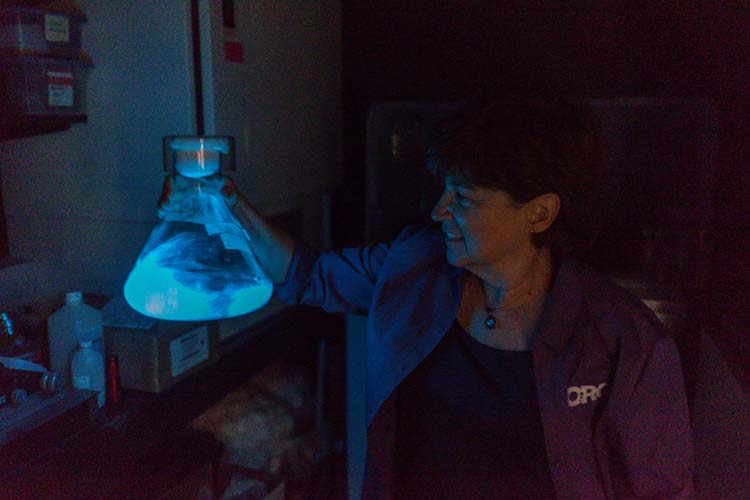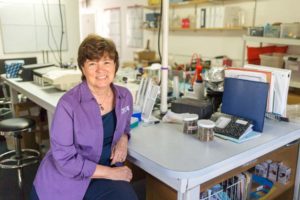
Last weekend, local marine biologist and deep-sea explorer Dr. Edie Widder became just the sixth woman to receive a Citation of Merit from New York City’s famed Explorers Club. Founded in 1904, the Club was home base for Robert Peary, Sir Edmund Hillary, Thor Heyerdahl, Neil Armstrong and many of the other of the most notable 20th century explorers.

Dr. Edie Widder
The Club has given the Citation of Merit award since 1962, but didn’t admit women members until 1981. Widder, founder and chief scientist at the Ocean Research and Conservation Association in Fort Pierce, received the award at the Club’s 114th annual dinner in Manhattan on March 10.
The Citation is given to recognize an “outstanding feat of exploration or services to the Club.” In Widder’s case, that feat was the sighting and video recording of the giant squid in its natural habitat in 2012, an accomplishment called, “the holy grail of natural history cinematography.”
Widder, who earlier received a MacArthur Genius Award for her work explaining bioluminescence, the phenomenon of sea creatures that give off light, has spent years adapting and creating technology to lure and view denizens of the deep. Reversing past exploration techniques, Widder uses technology to attract and identify, not attack and capture, deep sea species.
To effectively lie in wait for the giant squid in a small submarine, at a time when multiple teams of scientists were vying to find and film the massive and mysterious animal, Widder first had to quiet the submersible’s propulsion and power source so sea creatures wouldn’t flee as the sub dropped half a mile down into the waters off Japan’s Ogasawara archipelago.
Second, she had to develop a strong red light so she and her team could see and record the giant squid without being seen in return by the near-mythical creature. Infrared light “is absorbed instantly in the water,” she said. Most sea creatures can only see blue light, an adaptation due to blue light traveling great distances in ocean water.
Third, Widder created a quiet and remotely operated sea camera that detects and measures bioluminescence and records sharp images within the red-light spectrum. She calls it the “Eye-in-the-sea.”
Fourth, Widder developed a lure to attract sea predators, eventually capturing images of the most elusive of all, the giant squid, once known as the kraken, thought to devour ships and apt to be mistaken for an island.
The lure was designed based on her work with bioluminescence, mimicking a deep-ocean jelly fish that gives off a rotating blue light when attacked. Her thinking was that the squid would rocket to the site of the apparent attack to devour whatever was trying to eat the jellyfish.
The video footage she took of the giant squid, which went viral around the world when it was released, shows the creature hyper-extending, like an umbrella reversed by a high wind to take the blue light bait. In Widder’s TED Talk about the expedition, she calls the animal’s sucker-lined splay of long arms around its central beak “the full Monty.”
After working at the Monterey Bay Aquarium in California and at Harbor Branch Oceanographic Institute for 16 years as a senior scientist, Widder founded ORCA in 2005 as a nonprofit dedicated to saving the ocean and Indian River Lagoon from pollution.
“After receiving so much from the ocean, it was time to give back,” said Widder, who used her $500,000 MacArthur Fellowship to launch the research and advocacy organization, which is headquartered in the historic Coast Guard Station on the Fort Pierce Inlet.
Soon after forming ORCA, Widder traveled the area giving presentations, warning that the lagoon, “once the most biologically diverse estuary in the U.S.,” was approaching “a tipping point, beyond which it would collapse into an algae-dominated system.”
Her warnings were prophetic and shortly afterward a tipping point was indeed reached when unprecedented algae blooms infested much of the lagoon, killing off a majority of the seagrass that is the foundation of the estuary’s ecosystem.
The blue-green algae bloom along St. Lucie County’s stretch of the lagoon was so large “it could be seen from outer space,” Widder said. The brown algae tide around Titusville depleted the oxygen, “causing a massive fish kill.”
Widder hopes her latest prize will draw donations and support to carry on ORCA’s work, which has included a network of real-time water testing and monitoring devices called Kilroys and a range of research programs aimed at finding ways to reduce pollution and reverse the decline of the Indian River Lagoon.



